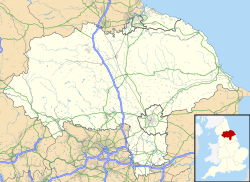History
The first lifeboat in Scarborough was instituted by public donation costing just over £212. [3] and saw its first launch in November 1801, when it went to the aid of a stricken vessel named Aurora in Scarborough Bay. [4] The first boat was actually built in Scarborough to a design by Henry Greathead, who had designed and built a boat for Whitby and Redcar lifeboat stations.
A replacement boat was built and supplied to the rescue crews in the town in 1823. The first lifeboat station was at the junction of Foreshore Road and Valley Road in the town. In 1821, the station was relocated near to its present site by the West Pier in Scarborough Harbour, however it was on the landward side of Foreshore Road. [4]
At a meeting of the RNLI committee of management on Thursday 4 April 1861, in reference to a letter from John Woodall of Scarborough, and with copies of resolutions, it was decided to accept the request of the Scarborough Lifeboat Committee, who had unanimously agreed to join the Institution, and that a new lifeboat and carriage were to be provided to Scarborough. [7]
The station was renovated, and Amelia, a new 32-foot (9.8 m) Peake-class self-righting 'Pulling and Sailing' (P&S) lifeboat, one with both sails and (10) oars, arrived in Scarborough on 26 September 1861. [8]
Just 5 weeks later, on 2 November 1861, the Amelia was wrecked, on its first service, after being launched to the aid of the schooner Coupland. (See Notable launches). Within a week, a replacement lifeboat was dispatched to Scarborough. Formerly the Royal Thames Yacht Club at Walmer, the boat had been at the boat-builders to be lengthened. Funded from the gift of Mrs Cockroft of Scarborough, the lifeboat was named Mary on arrival in Scarborough. [9]
In the early 1870s, two cast iron pillar collection boxes were erected to aid with fundraising, one at the Old Cliff, next to the gates to the Spa Bridge, near the Grand Hotel, and a second one, outside the Crown Hotel on The Esplanade. [10]
In 1914, the Scarborough lifeboat Queensbury (ON 111) was launched to assist in the rescue of the SS Rohilla off the coast at Whitby. Like many other lifeboats used in the rescue, she couldn't get near to the Rohilla because of the swell. [11]
In 1940, a new lifeboat station was built next to the West Pier; the old lifeboat house was later converted into an amusement arcade on the seafront. The 1940 lifeboat house had to be adapted for the larger Mersey-class lifeboat Fanny Victoria Wilkinson and Frank Stubbs in 1991, which involved widening and heightening the door.
A new lifeboat station was opened in 2016, which had been designed by the York architectural firm of Brierley Groom. Approval for the new £3 million building was granted by the Borough Council in 2014. [15]
In 2018, the coxswain of the crew was dismissed; the RNLI released a statement that he had organised an operational training exercise without proper authority. The former coxswain stated that he had "the blessing and clearance of the lifeboat operations manager and several others". [16] After a groundswell of support for the sacked individual, the RNLI later released a further statement detailing their decision to stand down the coxswain citing the lack of trained professionals on the boat when she was put to sea in rough weather. [17]



